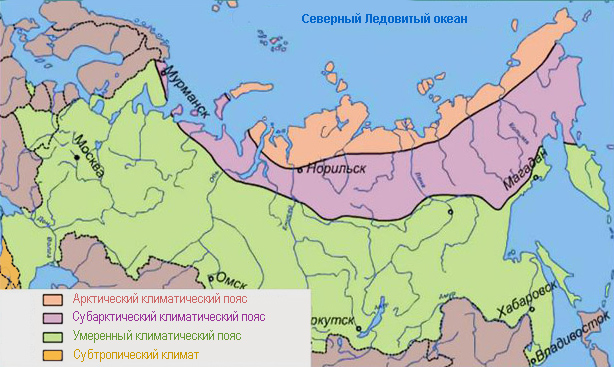Subarctic climatic zone runs between marks 60 and 70 o north latitude. Neighborhood with arctic zone expressed in severe weather conditions: long cold winters, strong winds, boggy area, rare summer warming up to +15 o C.
Such weather conditions differ from the Arctic zone only in a large amount of precipitation, a slightly higher average annual temperature and fewer permafrost zones. The large number of swamps is due to heavy rainfall, which cannot completely evaporate under the weak action of the sun. Industrial construction in such an area is impossible, therefore there is a minimum population density in Russia.
Climate of the subarctic zone of Russia
Weather in the Russian subarctic is controlled by streams air masses: summer - temperate latitudes, and in winter - arctic. Siberian part has a pronounced continental character... In calm, clear weather, the air is greatly cooled.

(Schematic map of climatic zones of Russia)
Average precipitation in flat areas of the subarctic climatic zone Russia -300-400mm, the main share of which falls on summer rains, sleet and winter snowfalls. The thickness of snow on the Central Siberian Plateau reaches 1 meter on the windward slopes and does not exceed 40 cm in the northeastern part.
Cities and regions of the subarctic belt of Russia
The climatic data is influenced by the location: in the coastal regions, the largest amount of precipitation is noted, but more warm summer... The table contains data for the last ten years about climatic conditions Russian settlements located in the subarctic:
In Russia, the northeast of Siberia is referred to the subarctic zone, Far East, southern islands Barents Sea... The northernmost inhabited point of the planet, the village of Oymyakon, is located in the subarctic belt. The temperature minimum of winter here was recorded at around -70.5 o C. Record low rates are explained by the location of the village. It is located in a natural "cold cellar" - a continental depression surrounded on all sides by high ridges, through which warm air masses cannot pass. The human body can more easily endure the strongest frosts of northeastern Yakutia than frosty days in the Arctic, since the wind speed in this territory is much lower




